How intrepid it it to take a trailer sailer from Northern Territory to Derby WA?
Find out in this four part story by Suzan Muir.
A tall Indigenous Australian man ambled down the Wyndham wharf with a little girl in tow, an exquisite flower of a child in her frilly dress and long black curls. She balanced above the swirling muddy waters of the Cambridge Gulf, tugging on her grandfather’s hand, leaning out as far as he would let her.
“Careful,” he said, “Big croc lives in water here. You don’t want to be his tucker.”
She grinned up at him, continuing to tug him towards the edge, until he picked her up and planted her safely on his hip.
“Where you goin’?” He asked, pointing his chin at Mystique, our eight metre, trailerable yacht straining against her lines as the racing ebb tide tried to powerfully entice her seaward.
“Around to Derby,” said Jon, “We’ve got four months. We’ll pull her out there and put her on the trailer and drive back home.”
The grandfather whistled, shaking his head, “She sure is small for such a long journey. You gonna live in that for four months? How do you fit enough food in?”
Jon slowly coiled a rope as he answered, “Food’s mostly dehydrated and a few tins and some rice and flour. Should be plenty. We will have to get water along the way though.”
“Hmmm,” answered grandpa, “When you go up those creeks for water, in your little tinny, watch out for crocs. They live up in those rocky creeks in winter.”
“Thanks,” said Jon, “We’d better catch this tide. See you later mate.”
I climbed down into the cockpit and released the wooden tiller, Jon untied the lines and leapt in as Mystique swung into the main current.
We were swept quickly northward. As I steered into midstream I looked back to see the waving figures of the old man and child, their faint cries of farewell whipped away to the south.
With increasing wind against tide the chop became steep, our six kilowatt engine propeller started lifting out of the water as Mystique began to pitch her way down the gulf like a wildly bucking horse.

On that first day, images of the previous nights bon voyage party kept me company during the long hours at the tiller. Chris and Jane Dennis, who were babysitting our four wheel drive and boat trailer, came down in the warm sultry evening with a few beers in hand. We sat on the wooden pier, our legs dangling over the edge, watching Mystique bob in the eddying water below.
It took six short, uncomfortable days of motoring into a headwind to finally reach the entrance to the sea.
We holed up for our last night on the west side of the Cambridge Gulf in the Helby River mouth. A good weather forecast saw us setting out at 2am under a sickle moon to round Dessoujour Point.
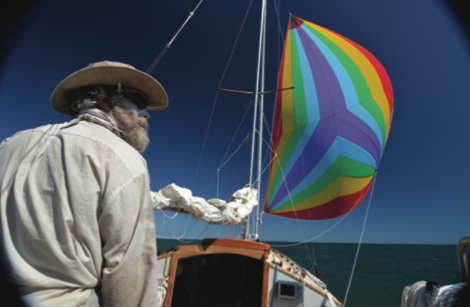
The lighthouse on Lacrosse Island at the entrance flashed on and off as we slipped through the adrenalin and darkness into the Joseph Bonaparte Gulf. With the dawn light the murky brown of the Cambridge Gulf had transformed into a beautiful deep jade green sea.
“Nice initiation into the Timor Sea,” I said, as we motor-sailed along the coast over a gentle rolling swell, paralleling low orange cliffs to our port side. Jon nodded but gestured towards the ominous band of purple rain clouds that filled the northeast sky.
At around 2p.m. we sighted Revely Island, guarding the entrance to the Berkeley River. The west coast of the J.B Gulf affectionately known as ‘Joseph Blownapart Gulf’, is a lee shore to the prevailing easterlies and both Reveley and Koolama provide protected anchorages.
Approaching Revely from the south we identified the narrow channel between the coral reefs and simultaneously saw a yacht approaching from the north east. The closer we got to Revely the clearer it became that the other yacht was going to attempt to run the channel at exactly the same moment as us.
We had been at the helm for twelve hours and I had anticipated being relieved from the anxiety of the exposed lee shore within minutes. I realised I was going to have slow Mystique and motor away into a circular holding pattern to allow the other yacht safe access to the deep but narrow channel.
Delaying my gratification of finally reaching the security of a quiet anchorage did not come easily. I seem to remember being just a little unreasonable and may perhaps have been heard to mutter something like, “get out of my f*****g ocean!” An indication, perhaps, of my feeling of being overwhelmed in regard to the voyage ahead: four months of threading Mystique through the ‘eye of the needle’ of a thousand reefs, while under the powerful and relentless influence of the currents created by the 12m tidal ebb and flow.
Drowning was not the only possible consequence of hitting a reef in this remote wilderness; that would be nice and simple really in comparison to the other rather nasty possibility of being eaten alive by a green armoured dinosaur. Got to keep that imagination in check, so, back to the tiller.
We eventually got our turn at the channel and tucked in behind Revely, anchoring in sand just 15m away from the other yacht. We slept lightly for a few hours waiting for the tide to rise enough to motor across the wide bar of breaking waves and shallows at the Berkeleys entrance.
Once inside the deep and slowly flowing river we were able to relax and found a great anchorage at the head of Casaurina Creek, deep and wide enough to safely shelter five or six full-keeled vessels. Shortly after our arrival we were joined by S.V. Nikita and a converted prawn trawler, Melita, both which had made the overnight crossing from Darwin to the Berkeley.
Brett was a live-aboard sailor and the skipper of Nikita, a 40 foot deep keeler; the yacht that
we had given way to as we approached Revely. Having been up all night Brett was bone-tired and was even more desperate for rest than we had been. We were to cross paths with Brett several times as we made our way slowly around to Derby and became somewhat indebted to him for his generous help on more than one occasion.
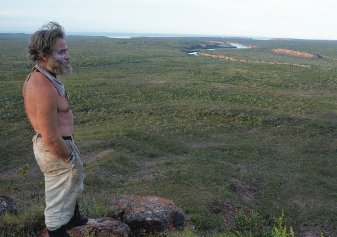
At the head of Casaurina Creek was a waterfall with a large flat rock beneath it. It looked like a perfect crocodile basking place but we did not see any crocs during our couple of nights in the creek. We were able to row our dinghy across to the rock, clamber carefully onto its slippery black surface and fill up several ten litre water bags, keeping constant watch all the while.
The Berkeley is a pristinely beautiful river, its water reflecting the deepest blue, mirroring the orange cliffs that line its course on both sides.
There are some simple Bradshaw paintings a short three kilometre to four kilometre walk from the top of the falls in Casaurina Creek. Because of the security of the anchorage in the head of the creek we decided Mystique would be okay by herself and we could do an overnight walk to Mount Casaurina, camping on top.
From its low summit we looked back down on the curving course of the Berkeley and the wild coast line to the north and south. It is remarkable for its vastness, its pristine awesome wilderness; primordial in its stark absence of civilisation and achingly beautiful.
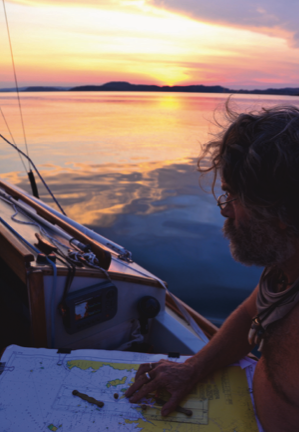
We chose the slack tide to exit the Berkeley River and, with our keel fully raised, were able to easily cross the bar in gentle conditions, then begin to goose-wing it up the coast under a 15 to 20 knot south-easterly. Perfect sailing conditions for our small boat, but not for long as the starboard top spreader on the mast snapped off.
Jon quickly dropped the main and used the main’s halyard to tie into the chain plate, supporting the mast on the slack side. The headsail alone continued to pull us along at about four knots.
Ahead, just out from the insignificant Green Point we could see a little white water. Brett was coming up quickly behind us in Nikita, looking like he was going to make a wide pass of that area; we just continued on our course, one that would take us right through the middle of the seemingly tiny white caps.
Ten minutes later we had waves breaking into the cockpit and were being thrown about all over the place by those, ‘tiny white caps.’ I was holding grimly onto the tiller and trying to minimise our rolling, how much worse it was going to get?
As quickly as the chaotic sea had appeared around us we were spat out into calm water.
A final piece of advice, just prior to our departure from our artist/sailor friend Jane, popped in to my head: “Go wide of the points!”
Right, that is what she meant! From that moment on we went wide around the points.
Late in the day our forward progress slowed, becoming imperceptible as the tidal stream turned and exerted its southward pull. We fired up the engine hoping that it would add enough momentum to get us safely anchored before dark. Again the prop kept popping out of the water as we pivoted over the high point of each swell.
Progress on the small chart plotter continued to appear negligible and we felt a horrible sense of being indefinitely suspended in place on the darkening sea, unable to make any headway in the clutches of the powerful tide. Finally though, just after sunset, at the end of another twelve hour day and 46 nautical miles, we rounded Cape Rulhieres and into the protection of Kalooma Bay. We had made it to the mouth of the iconic King George River.
Kimberly antics
The King George is one of the busiest yachtie hubs in the Kimberley. Once inside the river
we found we were anchored for a few days with about six other boats and in the brief company of three large Zodiacs, filled with people from a cruise ship anchored in Kalooma Bay.
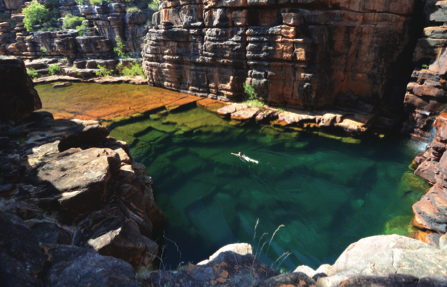
I could see the cruise ship with all its decadent wealth sitting serenely out there. We had run out of fresh vegetable and fruit several days ago. That fact, combined with the presence of the hulking cruise ship, had a profound effect on my psyche. Leaping out from some dark hiding place came my swaggering, leering, ‘inner pirate.’ I immediately knew how to unleash this newly birthed aspect of myself.
“Hey Jon,” I said, rubbing my hands together gleefully, “How about tonight we have a wash, dress up in our glad rags and, under the cover of darkness, row out to the cruise ship and board her? They won’t recognise all their clients by face, they’ll never know we aren’t supposed to be on board. We can find the fridge and raid it for fresh fruit and vegetables!”
I was already salivating. Jon looked at me and laughed, “You’re not serious, right?”
“I am,” I said, “it’s a great plan. It would work don’t you reckon?”
“Hmmm, yes,” he agreed, ‘it’s a great plan and rather tempting, but I think maybe we’d better not.”
I was a little crestfallen but also relieved somewhat by Jon’s response. Being first mate on this voyage I pulled rank on my disappointed inner pirate and ordered him back down below where he belonged.
The shadow filled, watery amphitheatre created by the 100m sandstone cliffs of the main King George Falls is everyone’s ‘must see.’ We checked it out from our dinghy along with people in several other private and commercial tenders. It is a majestic awe inspiring space but the crowds detracted from it a bit.
One of the absolute gems of our entire journey was the deep azure green rock pool at the top of the East King George Falls. You can leave your yacht anchored in the main King George River and motor over to the east falls in your dinghy if you want, as the shallow basin guarding the entrance to the falls is not navigable to full keel yachts.
We gingerly motored over in Mystique, with the keel up she draws just 18 inches, keeping a sharp look out from the bow for the ubiquitous sandbars.
It is a climb up a narrow steep rocky gully to the top of the falls. There is a fixed rope to help you climb up if you dare to risk your life on such an unpredictable bit of gear.
We left it alone and Jon climbed first. He belayed me with our own climbing rope at one point where I felt uncertain about whether I would fall. We both have climbing experience and I would only recommend this ascent if you are very comfortable with exposure and with moving over nearly vertical rock.
The pool at the top of the falls is the most exquisitely beautiful place I have ever been in my life! We camped and swam there in that paradise for two days and nights. There were no Pina Coladas though, so if that is your idea of paradise….
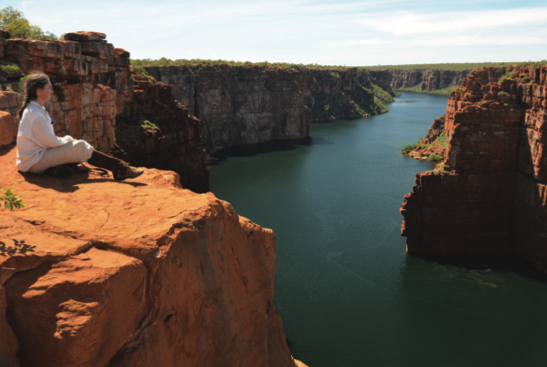
It was here that we met the inimitable Trevor. His tall lanky frame appeared over the lip of the rock hole on day two; a little shaken after almost falling onto the rocks below while climbing.
We invited him to join us for ‘high tea’ and dates. High tea, for us, consists of a cup of tea which is drunk in an elegant and relaxed manner, taken with the little finger on the hand holding the cup slightly separated and cocked.
We lounged companionably on the sun- warmed orange sandstone. A sparkling creek flowed beside us before arcing over a small cliff into the plunge pool below. Several cups of tea flowed too as we chatted, getting to know each others’ journeys and boat stories.
Trevor had previously made three circumnavigations of Australia in his yacht. This time he was sailing alone from Darwin as far as the King George River and then back, in Tucanu, a 30 foot catamaran he had built.
He was living mostly off fish and bush tucker. Trevor fished standing up in his homemade, broad-based, two part skiff and poled himself around the shallows using a long stick.
“Got to be careful not to get knocked off balance. Sometimes the crocs bash into the skiff, especially if there’s fish guts in the bottom of it,” he said.
Trevor also had no depth sounder on his catamaran and instead used a line with knots at 10m intervals with a lead weight tied to the end, which he cast ahead of his boat to determine how far he was from the river or sea bed. He invited us to drop in to visit him at Tucanu the following day. We returned to the main King George River the next morning. Trevor came poling past, his skiff floor awash with fish heads and guts.
“Here you go,” he yelled, as he flung a sizeable barramundi up into our cockpit and then continued on. “See you a bit later,” he waved, as he poled on by.
A few hours later we were ready to row across for a visit and I jumped on the VHF, “We’re ready to come across now and thanks for the barra!”
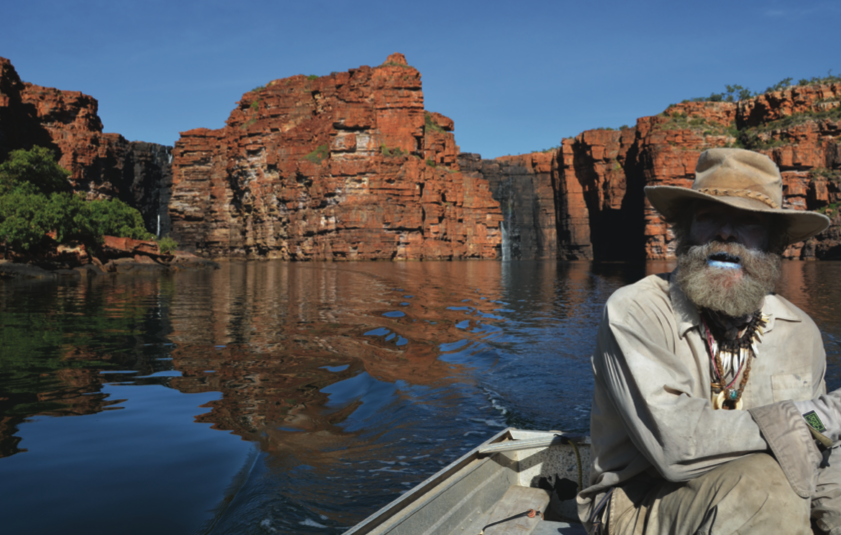
When we boarded Tucanu, a lovely, light- filled space with headroom and a great balcony overlooking the bridge deck, Trevor sat us down to freshly baked rock cakes, studded with plump sultanas and to cups of sweet milky tea.
“Ahh,” he said, “you know it’s probably best not to talk about barramundi on the VHF. I’ve had at least three calls in the last five minutes wanting to know where I caught ‘em. It’s gone viral, there’s barra on the air waves, barra floating in the ether. Every man and his dog is just mad for barra!”
“Sorry,” I replied, “I had no idea it was going to create that sort of problem for you.”
“It’s OK,” said Trevor, “it’s more a problem for the fish really, too many fishermen in one place. I just told ‘em a few white lies to get them off my trail.”
Moving on
That evening, a satellite phone chat with Dad gave us a forecast of 20 to 25 knots for the next day. We left the shelter of the King George River the following morning but, seeing Tucanu, still at anchor in Kalooma Bay, wondered if a more recently updated weather forecast was predicting stronger winds?
Shortly after we set sail the wind did begin to pick up and we soon had a steep following sea. I suggested that we duck around the corner into the relative shelter of Faraway Bay. Jon, being generally happy to sail conservatively when I feel anxious, readily agreed to drop anchor.
We watched the larger vessels, Nikita and Melita, roll on by, not as affected as our small boat by the increasing breaking waves.
We decided to use both the tide and the low wind hours typical of the wee hours of the morning to sail to Glycosmis Bay. Under a full moon we set off at about 2a.m. and had the most brilliant night sail ever.
The wind was a gentle, 10 to 15 knots and the sea mesmerising, striped with alternating ripples of silver moonlight and darkness. We ghosted silently between the dark animal like humps of the slumbering islands along our course.
On our approach to the entrance of Glycosmis there was a semi-submerged rock guarding the port side of the wider outer bay. We could hear waves crashing atmospherically against the rock and, as we passed by, saw luminescent flashes of white water in the dark thrown violently skywards, seemingly very close to the fragile shell of Mystique’s hull.
Dawn was close, we slowed Mystique so that she almost stalled, waiting for enough light
to allow us to see the channel that leads into the inner womb of Glycosmis. This inner bay is protected by 50m high sandstone cliffs all round, with a fresh waterfall in the back.
The inner sanctuary is only approachable by shallow draft vessels. It is a tricky little bit
of manoeuvring to stay in the deep water of the channel.
The channel is about 100m wide and you have to approach in such a way that you make a sharp 90 degree turn to port at the last moment before it narrows right down. In that moment one could potentially be pushed up onto the beach by the following breaking waves now hitting broadside.
With a more powerful engine than ours and more experience at the tiller the approach might be a little less hairy. Once inside the inner bay you are well protected from any weather. There are two deep anchorages outside in the main bay: one providing protection from the prevailing south easterlies and the other giving protection from the north.
We scrambled to the top of the waterfall in Glycosmis and had a wash, but I was reluctant to enter the long dark waterhole that spilled over the edge of the precipice. The waterhole was big enough to be home to large fresh water crocs, not known for preying on humans but it gave me the creeps thinking I might be swimming with them. Our friend, Jane, who had warned us to “go wide around the points,” had her foot badly lacerated by a freshie.
We camped under some amazingly weathered overhangs next to the creek. The land there
is incredibly sensuous and alive. The orange, purple and salmon-hued stone is covered in a shiny smooth skinned patina; so silky that stroking it elicits the pleasure one usually experiences through caressing a cat or well- loved dog. I was missing our little dog boys.
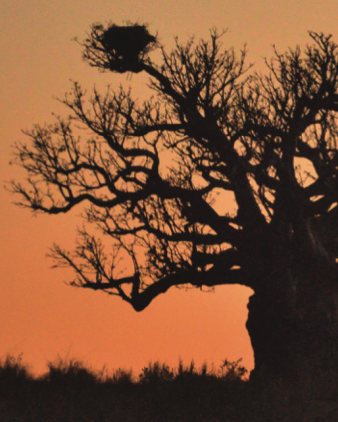
But the boabs! Ahh, the voluptuous boabs, dotted along the cliff tops, silently extending their gnarled limbs in ever-present yearning towards the sun, the moon and the stars. Such ancient beings, silently watching season after season unfold around them.
These trees were the reason I had returned to the Top End. I was willing to do it, to explore the untamed coast where the boabs are abundant.
For a year prior to setting sail from Wyndham, I had been saying to Jon, “I have to go back to that wild country, the boabs are calling!”
We left Glycosmis earlier than planned because a perfect weather window appeared
in which to sail around the infamous Cape Londonderry, the most northern part of Western Australia, Warnings abound in the ‘Western Australian cruising guide:’ ‘a minimum 5nm clearance of the cape is recommended, work the tide when possible. Caution: a 3.5 knot current running against a 25 knot easterly can result in an extremely steep and dangerous breaking sea.’
Immediately after Londonderry is the less notorious Cape Talbot connecting the two capes and, fanning out five nautical miles to the north, are miles of fringing reef. There is no safe anchorage between the two capes.
We had not experienced as calm and friendly a sea as we did rounding Londonderry. Fluffy little clouds hung in the blue sky and the sea was rippling with the gentlest of swells.
We felt relaxed and increasingly jubilant as we neared the westernmost edge. A few miles before we were to swing back south around the more minor Cape Talbot, Jon pointed ahead and said, “What do you think that is? A rock? A whale? Or, perhaps a wreck?”
A large dark, smooth-edged lump rose above the shoaling reefs. As we drew closer the first sign that maybe it was not a whale was a short stick projecting skyward. Then there was
that awful moment when we both realised, unmistakably, that it was a large vessel lying on its side.
The shock deepened as we drew closer and an official looking orange dinghy appeared; a person could be seen climbing back and forth between the two vessels.
“Its happened recently,” I said as I leaned down into the cabin to flick on the VHF. There were no requests for assistance and the activity between the two boats looked very much like a salvage operation.
We supposed that the wrecked boat had met Cape Londonderry under very different weather conditions than what we were experiencing.
We later heard that the yacht had been returning from an Indonesian rally and had experienced several days of bad weather resulting in the unfortunate combination of an exhausted crew, a night time storm and Cape Londonderry. The captain and family had been picked up from their yacht the day after it had run aground by a passing catamaran called, Howzat.
Rounding Talbot, close to the end of our 38nm day, our main motor suddenly stopped and refused to start. The wind was very light. For the first time, up went the rainbow spinnaker and out came both the dinghy outboard and the spare 1.5kW engine. With all employed we accelerated to the magnificent speed of two knots.
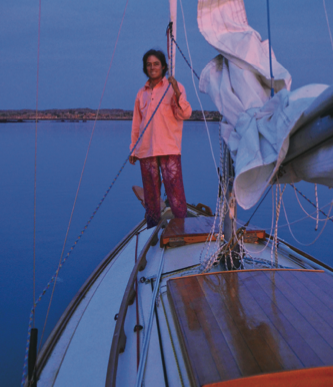
Just after dark we limped into the safe anchorage of a wide sandy bay 1.5nm south of Cape Talbot.
We had completed about a third of the total distance from Wyndham to Derby in a slow 27 days and had finally tucked down and around into the generally more sheltered side of the complex Kimberley Archipelago, away from the prevailing winds.
Up until now we had only seen the tracks of crocodiles in the sand. It was to be through the next expanse of wilderness that they were to materialise. The fascinating, yet deep horror of close encounters with these amazing ancient hunters was to became a regular part of the voyage.
Stay tuned.
Suzan is a freelance writer, lover of all things wild, (including her husband) and grower of organic food. Exploring wilderness through sailing, kayaking and bushwalking provides an exciting balance to her mostly agrarian home life in the forest. She’s also addicted to big chunks of desert dreaming and nature yoga.
























